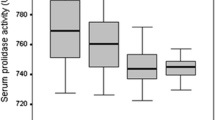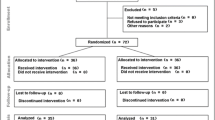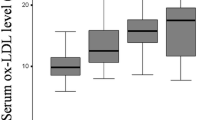Abstract
The purpose of this study was to determine serum oxidative/antioxidative status in patients with knee osteoarthritis and its relation with prolidase activity, which plays an important role in collagen metabolism. Serum antioxidative status was evaluated by measuring total antioxidant capacity (TAC), thiol level and catalase enzyme activity in patients with osteoarthritis and in healthy controls. Serum oxidative status was evaluated by measuring total peroxide (TP) and lipid hydroperoxide. Oxidative stress index (OSI) was calculated. Prolidase enzyme activity was measured to investigate the collagen metabolism. Serum TAC, thiol level, catalase activity and prolidase activity were significantly lower in patients than in controls (P < 0.001, for all). In contrast, TP, lipid hydroperoxide and OSI values were significantly higher in patients than in controls (P < 0.001 for all). Further, prolidase activity was negatively correlated with TP and OSI, and positively correlated with TAC. The present results indicate that the oxidant parameters increased and antioxidant parameters decreased in patients with osteoarthritis; therefore, these patients may be exposed to a potent oxidative stress. Decreased collagen metabolism may be related with oxidative stress, which has a role in the ethiopathogenesis and/or in the progression of the disease.

Similar content being viewed by others
References
Halliwell B, Gutteridge JMC (2000) Free radicals in biology and medicine, 3rd edn. Oxford Science Publications, Oxford, pp 617–624
Mazzetti I, Grigolo B, Pulsatelli L, Dolzani P, Silvestri T, Roseti L et al (2001) A differential roles of nitric oxide and oxygen radicals in chondrocytes affected by osteoarthritis and rheumatoid arthritis. Clin Sci 101:593-599
Henrotin YE, Bruckner P, Pujol JP (2003) The role of reactive oxygen species in homeostasis and degradation of cartilage. Osteoarthritis Cartilage 11:747-755
Fermor B, Weinberg JB, Pisetsky DS, Misukonis MA, Banes AJ (2001) The effects of static and intermittent compression on nitric oxide production in articular cartilage explants. J Orthop Res 19:729-737
Deberg M, Labasse A, Christgau S, Cloos P, Henriksen BD, Chapelle JP et al (2005) New serum biochemical markers (Coll 2–1 and Coll 2–1 NO2) for studying oxidative-related type II collagen network degradation in patients with osteoarthritis and rheumatoid arthritis. Osteoarthritis Cartilage 13:258-265
Lupi A, Rossi A, Vaghi P, Gallanti A, Cetta G (2005) N-benzyloxycarbonyl-l-proline: an in vitro and in vivo inhibitor of prolidase. Biochim Biophys Acta 1744:157-163
Miltyk W, Surazynski A, Kasprzak KS, Fivash MJ, Buzard GS, Phang JM et al (2005) Inhibition of prolidase activity by nickel causes decreased growth of proline auxotrophic CHO cells. J Cell Biochem 94:1210-1217
Palka J, Surazynski A, Karna E, Orlowski K, Puchalski Z, Pruszynski K et al (2002) Prolidase activity disregulation in chronic pancreatitis and pancreatic cancer. Hepatogastroenterology 49:1699-1703
Scott WW, Lethbridge-Cejku M, Reichle R, Wigley FM, Tobin JD, Hochberg MC et al (1993) Reliability of grading scales for individual radiographic features of osteoarthritis of the knee. Invest Radiol 28:497-501
Kaur H, Halliwell B (1994) Evidence for nitric oxide-mediated oxidative damage in chronic inflammation. Nitrotyrosine in serum and synovial fluid from rheumatoid patients. FEBS Lett 350:9–12
Kaur H, Edmonds SE, Blake DR, Halliwell B (1996) Hydroxyl radical generation by rheumatoid blood and knee joint synovial fluid. Ann Rheum Dis 55:915–920
Erel O (2004) A novel automated method to measure total antioxidant response against potent free radical reactions. Clin Biochem 37:112-119
Ahn MR, Kumazawa S, Hamasaka T, Bang KS, Nakayama T (2004) Antioxidant activity and constituents of propolis collected in various areas of Korea. J Agric Food Chem 52:7286-7292
Harma M, Harma M, Erel O (2005) Measurement of the total antioxidant response in preeclampsia with a novel method. Eur J Obetet Gynecol Reprod Biol 118:47-51
Yeni E, Gulum M, Selek S, Erel O, Unal D et al (2005) Comparison of oxidative/ant oxidative status of penile corpus cavernosum blood and peripheral venous blood. Int J Impot Res 17:19-22
Harma M, Harma M, Erel O (2003) Increased oxidative stress in patients with hydatidiform mole. Swiss Med Wkly 133:563-536
Yanik M, Erel O, Kati M (2004) The relationship between potency of oxidative stress and severity of depression. Acta Neuropsychiatrica 16:200-203
Harbeck HT, Mentlein R (1991) Aminopeptidase P from rat brain. Eur J Biochem 198:451–458
Myara I, Charpentier C, Lemonnier A (1982) Optimal conditions for prolidase assay by proline colorimetric determination: application to imminodipeptiduria. Clin Chim Acta 125:193–205
Chinard FP (1952) Photometric estimation of proline and ornithine. J Biol Chem 199:91
Goth L (1991) A simple method for determination of serum catalase activity and revision of reference range. Clin Chim Acta 196:143-152
Hu ML, Louie S, Cross CE, Motchnik P, Halliwell B (1993) Antioxidant protection against hypochlorous acid in human plasma. J Lab Clin Med 121:257-261
Arab K, Steghens JP (2004) Plasma lipid hydroperoxides measurement by an automated xylenol orange method. Anal Biochem 325:158–163
Towheed T, Maxwell L, Anastassiades T, Shea B, Houpt J, Robinson V et al (2005) Glucosamine therapy for treating osteoarthritis. Cochrane Database Syst Rev 18:2946
Yudoh K, Nguyen T, Nakamura H, Hongo-Masuko K, Kato T et al (2005) Potential involvement of oxidative stress in cartilage senescence and development of osteoarthritis: oxidative stress induces chondrocyte telomere instability and downregulation of chondrocyte function. Arthritis Res Ther 7:380–391
Martin JA, Brown TD, Heiner AD, Buckwalter JA (2004) Chondrocyte senescence, joint loading and osteoarthritis. Clin Orthop Relat Res 427:96–103
Myara I, Myara A, Mangeot M, Fabre M, Charpentier C (1984) Lemonnier A. Plasma prolidase activity: a possible index of collagen catabolism in chronic liver disease. Clin Chem 30:211–215
Karna E, Surazynski A, Palka J (2000) Collagen metabolism disturbances are accompanied by an increase in prolidase activity in lung carcinoma planoepitheliale. Int J Exp Pathol 11:341
Wolanska M, Sobolewski K, Drozdzewicz M (2001) Integrins and prolidase activity in uterine leiomyoma during tumor growth. Ginekol Pol 72:121–126
Wolczynski S, Surazynski A, Swiatecka J, Palka J (2001) Estrogenic and antiestrogenic effects of raloxifene on collagen metabolism in breast cancer MCF-7 cells. Gynecol Endocrinol 15:225–233
Author information
Authors and Affiliations
Corresponding author
Rights and permissions
About this article
Cite this article
Altindag, O., Erel, O., Aksoy, N. et al. Increased oxidative stress and its relation with collagen metabolism in knee osteoarthritis. Rheumatol Int 27, 339–344 (2007). https://doi.org/10.1007/s00296-006-0247-8
Received:
Accepted:
Published:
Issue Date:
DOI: https://doi.org/10.1007/s00296-006-0247-8




